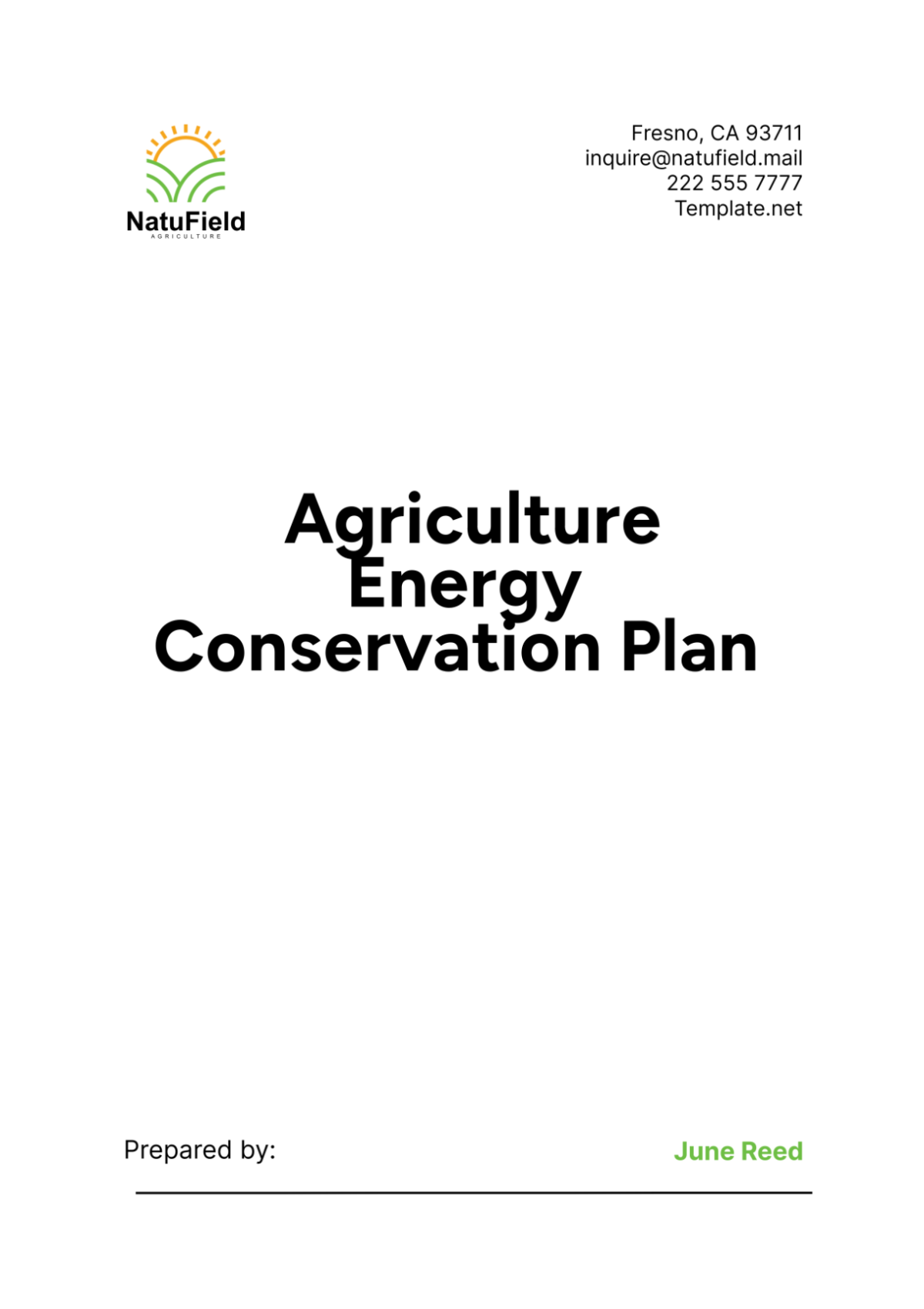Free Agriculture Energy Conservation Plan

I. Overview
A. Introduction
The [Your Company Name] Agriculture Energy Conservation Plan aims to address the critical need for energy efficiency and sustainability in our agricultural operations. With the ever-increasing demand for food and the rising cost of energy, it is essential to adopt measures that not only reduce energy consumption but also enhance the overall productivity and sustainability of our farming practices.
The primary purpose of this plan is to outline a comprehensive strategy for conserving energy in agricultural processes. This will involve assessing current energy use, identifying areas for improvement, and implementing a range of energy conservation measures. By doing so, [Your Company Name] aims to set a benchmark for sustainable agricultural practices that contribute to both environmental conservation and economic viability.
B. Goals and Objectives
The key goals and objectives of the [Your Company Name] Agriculture Energy Conservation Plan are as follows:
Reduce Energy Consumption: Implement strategies to significantly reduce the amount of energy used in various agricultural operations without compromising productivity.
Enhance Energy Efficiency: Upgrade existing equipment and processes to more energy-efficient alternatives to maximize energy savings.
Promote Sustainable Agricultural Practices: Encourage the adoption of renewable energy sources and environmentally friendly practices that reduce the carbon footprint of agricultural activities.
By achieving these objectives, [Your Company Name] aims to foster a culture of sustainability within the agricultural sector and demonstrate the economic and environmental benefits of energy conservation.
II. Energy Consumption Analysis
A. Current Energy Use Assessment
To develop an effective energy conservation plan, it is crucial to understand the current energy consumption patterns in our agricultural operations. This involves a thorough assessment of energy use across different processes and equipment.
Energy Usage in Various Agricultural Operations
Agricultural operations at [Your Company Name] encompass a wide range of activities, including planting, irrigation, harvesting, processing, and storage. Each of these activities consumes varying amounts of energy, depending on the equipment used and the scale of operations.
For instance, irrigation systems, especially those that rely on electric pumps, can be significant energy consumers. Similarly, processing and storage facilities that utilize refrigeration or other forms of temperature control also contribute substantially to overall energy consumption. By breaking down energy use by activity, we can pinpoint areas where conservation efforts will have the greatest impact.
Operation | Equipment/Process | Energy Consumption (kWh) |
|---|---|---|
Planting | Tractors, Planters | 1,200 |
Irrigation | Electric Pumps | 3,500 |
Harvesting | Combines, Harvesters | 2,800 |
Processing | Refrigeration Units | 4,000 |
Storage | Temperature Control Systems | 2,200 |
Identification of High Energy-Consuming Processes and Equipment
By analyzing the energy consumption data, it becomes evident that certain processes and equipment are particularly energy-intensive. For example, irrigation systems and refrigeration units are typically among the highest consumers of energy. Identifying these high-energy consumers allows us to target them for energy-saving interventions.
B. Energy Audit
An energy audit is a systematic approach to evaluating energy use and identifying opportunities for improvement. It involves detailed measurements and analysis to uncover inefficiencies and recommend corrective actions.
Detailed Energy Audit Procedures
Conducting an energy audit at [Your Company Name] involves several steps:
Preparation: Gathering historical energy consumption data and understanding the scope of the audit.
Site Inspection: Visiting the agricultural sites to inspect equipment and processes, and to identify potential areas of energy waste.
Measurement: Using tools and instruments to measure energy consumption in real time, including electricity meters, thermal imaging cameras, and power quality analyzers.
Analysis: Analyzing the collected data to identify patterns of energy use and inefficiencies.
Recommendations: Develop a set of recommendations for energy conservation measures based on the findings of the audit.
Tools and Methods for Measuring Energy Consumption
Several tools and methods are employed during the energy audit to ensure accurate measurement and analysis of energy consumption:
Electricity Meters: Used to measure the amount of electrical energy consumed by different equipment.
Thermal Imaging Cameras: Help identify heat loss and inefficiencies in insulation and equipment.
Power Quality Analyzers: Assess the quality of power being supplied and consumed, identifying issues such as voltage fluctuations and harmonic distortions.
Data Collection and Analysis
Data collection is a critical component of the energy audit. It involves recording energy use over a specified period to capture variations and peak consumption times. This data is then analyzed to identify trends and pinpoint areas where energy conservation measures can be most effective.
III. Energy Conservation Strategies
A. Energy-Efficient Equipment and Technology
One of the most effective ways to conserve energy is to upgrade existing equipment and technology to more energy-efficient alternatives. This section explores various strategies and technologies that can be adopted to achieve significant energy savings.
Adoption of Energy-Efficient Machinery
Upgrading to energy-efficient machinery can lead to substantial reductions in energy consumption. For example, replacing old tractors and harvesters with newer models that feature advanced fuel injection systems and optimized engine performance can result in significant fuel savings. Similarly, using energy-efficient electric motors and drives in processing and storage facilities can reduce electricity consumption.
Use of Renewable Energy Sources
Integrating renewable energy sources into agricultural operations is a key strategy for reducing reliance on non-renewable energy and lowering overall energy costs. Solar and wind energy are particularly suitable for agricultural settings.
Solar Energy: Installing solar panels on farm buildings and open land can generate electricity for various farm operations. Solar water heating systems can also be used to provide hot water for cleaning and processing tasks.
Wind Energy: Utilizing wind turbines can generate electricity, especially in regions with favorable wind conditions. Small-scale wind turbines can be installed on farms to supplement energy needs.
Upgrading to Energy-Efficient Lighting and Irrigation Systems
Lighting and irrigation are two areas where significant energy savings can be achieved through upgrades:
Energy-Efficient Lighting: Replacing traditional incandescent or fluorescent bulbs with LED lighting can reduce energy consumption by up to 75%. LEDs have a longer lifespan and provide better illumination with less energy.
Efficient Irrigation Systems: Upgrading to drip irrigation or using automated irrigation systems with moisture sensors can optimize water usage and reduce the energy required for pumping water.
B. Operational Improvements
Operational improvements focus on optimizing the efficiency of agricultural processes and reducing energy waste through better management and scheduling.
Implementing Best Practices for Energy Conservation
Adopting best practices for energy conservation can lead to significant savings. For example, regularly maintaining and servicing equipment ensures it operates at peak efficiency. Training farm workers on energy conservation techniques and encouraging energy-saving behaviors, such as turning off equipment when not in use, can also contribute to overall energy savings.
Efficient Scheduling and Management of Agricultural Operations
Efficient scheduling and management of agricultural operations can minimize energy use. For instance, scheduling irrigation during cooler parts of the day can reduce evaporation losses and the energy required for pumping water. Similarly, optimizing the timing of planting and harvesting activities can enhance productivity and reduce energy consumption.
Maintenance Strategies for Reducing Energy Waste
Regular maintenance of equipment and infrastructure is crucial for preventing energy waste. This includes cleaning and servicing machinery, inspecting and repairing insulation, and ensuring that all systems are operating efficiently. Implementing a proactive maintenance schedule can help identify and address potential issues before they lead to significant energy losses.
C. Infrastructure Enhancements
Improving the infrastructure of agricultural facilities can lead to significant energy savings by enhancing insulation, ventilation, and energy monitoring.
Improvements in Farm Building Insulation and Ventilation
Proper insulation and ventilation are essential for maintaining optimal conditions in farm buildings while minimizing energy use. Improving insulation in storage facilities can reduce the need for heating and cooling, while adequate ventilation ensures that air quality is maintained without excessive energy consumption.
Installation of Energy Monitoring and Control Systems
Installing energy monitoring and control systems allows for real-time tracking of energy use and provides valuable insights into consumption patterns. These systems can automatically adjust energy use based on demand, ensuring that energy is used efficiently and waste is minimized.
IV. Renewable Energy Integration
A. Solar Energy
Solar energy is a versatile and sustainable source of power that can be effectively integrated into agricultural operations. This section explores the various applications of solar energy in farming.
Implementation of Solar Panels for Electricity Generation
Installing solar panels on farm buildings and open land can generate significant amounts of electricity, reducing reliance on grid power and lowering energy costs. Solar panels can power various farm operations, including lighting, machinery, and electric fences. The excess electricity generated can be stored in batteries or fed back into the grid, providing an additional source of income.
Use of Solar Water Heating Systems
Solar water heating systems use solar energy to heat water for cleaning, processing, and other farm activities. These systems consist of solar collectors that capture sunlight and convert it into thermal energy, which is then used to heat water. By using solar water heating systems, farms can reduce their reliance on conventional water heating methods, leading to significant energy savings.
B. Wind Energy
Wind energy is another renewable source that can be harnessed to meet the energy needs of agricultural operations.
Utilization of Wind Turbines for Energy Generation
Installing wind turbines on farms can generate electricity, particularly in areas with consistent and strong winds. Wind turbines convert kinetic energy from the wind into electrical energy, which can be used to power various farm operations. Small-scale wind turbines are suitable for individual farms, while larger turbines can generate surplus electricity that can be sold to the grid.
Evaluation of Wind Energy Potential in Agricultural Areas
Before installing wind turbines, it is essential to evaluate the wind energy potential in the area. This involves assessing wind speeds, direction, and consistency to determine the feasibility and efficiency of wind energy generation. Wind resource assessments can be conducted using anemometers and other meteorological instruments to gather accurate data.
V. Implementation and Monitoring
A. Development of an Implementation Plan
Implementing the Agriculture Energy Conservation Plan requires a well-structured and comprehensive approach. This section outlines the steps involved in developing and executing the implementation plan.
Setting Milestones and Timelines
Setting clear milestones and timelines is crucial for the successful implementation of energy conservation measures. This involves defining specific goals, such as the reduction of energy consumption by a certain percentage within a given timeframe. Milestones help track progress and ensure that the project stays on schedule.
Milestone | Description | Timeline |
|---|---|---|
Energy Audit | Complete energy audit of all operations | Month 1 |
Equipment Upgrade | Install energy-efficient machinery | Months 2-4 |
Solar Panel Installation | Install solar panels on farm buildings | Months 4-6 |
Training and Awareness | Conduct energy conservation workshops | Months 2-3 |
Monitoring System Setup | Install energy monitoring systems | Month 6 |
Allocation of Resources and Budget
Allocating the necessary resources and budget is essential for the successful implementation of the plan. This includes funding for equipment upgrades, renewable energy installations, and training programs. It is also important to allocate human resources, such as project managers and technical experts, to oversee the implementation process.
Stakeholder Involvement and Communication
Engaging stakeholders and maintaining open communication is vital for the success of the energy conservation plan. This includes involving farm workers, management, and external experts in the planning and implementation process. Regular communication ensures that everyone is aware of the goals, progress, and benefits of the energy conservation measures.
B. Monitoring and Evaluation
Monitoring and evaluation are critical components of the implementation process, ensuring that the energy conservation measures are effective and achieving the desired outcomes.
Setting Up an Energy Monitoring System
An energy monitoring system allows for real-time tracking of energy use and provides valuable data for analysis. This system should be capable of measuring energy consumption across different operations and identifying any deviations from expected patterns. By continuously monitoring energy use, it is possible to detect inefficiencies and make necessary adjustments promptly.
Regular Performance Reviews
Conducting regular performance reviews is essential to evaluate the effectiveness of energy conservation measures. These reviews should assess whether the goals and milestones are being met and identify any areas that require improvement. Performance reviews can be conducted quarterly, with detailed reports prepared for management and stakeholders.
Adjustments and Improvements Based on Data
Based on the data collected from the energy monitoring system and performance reviews, it is important to make adjustments and improvements to the energy conservation measures. This may involve refining operational practices, upgrading equipment, or enhancing training programs. Continuous improvement ensures that the energy conservation plan remains effective and achieves long-term sustainability.
Reporting and Documentation
Maintaining thorough documentation and reporting is crucial for tracking progress and demonstrating the impact of the energy conservation measures. This includes preparing detailed reports on energy consumption, cost savings, and environmental benefits. Regular reports should be shared with stakeholders to keep them informed and engaged in energy conservation efforts.
VI. Technology and Innovation
A. Adoption of Energy-Efficient Technologies
Implementing energy-efficient technologies in agriculture is critical for reducing energy consumption and operational costs. The following are key areas where [Your Company Name] can adopt innovative technologies:
Energy-Efficient Machinery
Upgrading to energy-efficient machinery can significantly reduce energy consumption. Modern tractors, irrigation systems, and processing equipment designed with energy efficiency in mind can improve productivity while lowering energy use.
Precision Agriculture Technologies
Precision agriculture technologies, such as GPS-guided equipment and variable rate technology (VRT), optimize the use of resources like water, fertilizers, and pesticides. These technologies ensure that inputs are applied precisely where needed, minimizing waste and energy use.
Reduced fuel consumption due to optimized machinery routes
Lower input costs through precise application
Enhanced crop yields and quality
B. Renewable Energy Integration
Integrating renewable energy sources into agricultural operations can further reduce dependence on fossil fuels and lower greenhouse gas emissions. Key renewable energy options for [Your Company Name] include:
Solar Power
Installing solar panels on farm buildings and fields can provide a reliable source of clean energy. Solar power can be used to operate machinery, power irrigation systems, and provide electricity for buildings.
Solar Power Implementation Plan Table:
Action | Description | Timeline |
|---|---|---|
Site Assessment | Evaluate suitable locations for panels | Month 1 |
System Design | Develop system specifications | Month 2 |
Installation | Install solar panels and inverters | Months 3-5 |
Commissioning | Test and activate the solar system | Month 6 |
Wind Energy
Wind turbines can be installed on farms to generate electricity. Small-scale wind turbines are suitable for rural areas with high wind potential and can supply power to agricultural operations.
Wind Energy Implementation Plan Table:
Action | Description | Timeline |
|---|---|---|
Wind Resource Assessment | Measure wind speed and direction | Months 1-2 |
Feasibility Study | Analyze economic and technical viability | Months 3-4 |
Permitting | Obtain necessary permits and approvals | Months 5-6 |
Installation | Install wind turbines | Months 7-9 |
C. Research and Development Initiatives
Investing in research and development (R&D) is crucial for advancing energy conservation in agriculture. [Your Company Name] will collaborate with universities, research institutions, and technology providers to develop and implement cutting-edge solutions.
Focus Areas for R&D:
Development of more efficient farming practices
Innovations in renewable energy technologies
Enhancement of precision agriculture tools
VII. Employee Training and Engagement
A. Training Programs
Providing comprehensive training programs for employees is essential to ensure the successful implementation of energy conservation measures. [Your Company Name] should focus on the following training areas:
Energy Conservation Practices
Employees should be trained on best practices for energy conservation, including efficient machinery operation, proper maintenance, and energy-saving techniques.
Training Program Schedule:
Training Topic | Duration | Target Audience | Frequency |
|---|---|---|---|
Efficient Machinery Use | 2 hours | Equipment Operators | Quarterly |
Maintenance Best Practices | 3 hours | Maintenance Staff | Biannually |
General Energy Saving | 1 hour | All Employees | Annually |
Use of Energy-Efficient Technologies
Training on the use of new energy-efficient technologies ensures that employees can operate equipment effectively and maximize energy savings.
Technology Training Schedule:
Technology | Training Duration | Target Audience | Frequency |
|---|---|---|---|
Precision Agriculture Tools | 2 days | Operators and Managers | Annually |
Solar Power Systems | 1 day | Technical Staff | As needed |
Wind Energy Systems | 1 day | Technical Staff | As needed |
B. Employee Engagement Initiatives
Engaging employees in energy conservation efforts is crucial for fostering a culture of sustainability.
Incentive Programs
Incentive programs can motivate employees to actively participate in energy conservation. Rewards and recognition for energy-saving ideas and practices encourage continuous improvement.
Awareness Campaigns
Raising awareness about the importance of energy conservation through regular campaigns helps keep energy efficiency top of mind for employees.
VIII. Financial Analysis
A. Cost-Benefit Analysis
Conducting a cost-benefit analysis is essential for evaluating the financial viability of energy conservation measures. This analysis compares the costs of implementing energy-saving initiatives with the expected benefits, such as reduced energy bills and operational savings.
Cost-Benefit Analysis:
Measure | Implementation Cost | Annual Savings | Payback Period |
|---|---|---|---|
Solar Panel Installation | $100,000 | $20,000 | 5 years |
Energy-Efficient Machinery | $50,000 | $12,000 | 4 years |
Wind Turbine Installation | $150,000 | $30,000 | 5 years |
B. Funding and Incentives
Identifying funding opportunities and incentives can help offset the initial costs of implementing energy conservation measures. [Your Company Name] should explore the following options:
Government Grants and Subsidies
Many governments offer grants and subsidies to support energy efficiency and renewable energy projects in agriculture. These financial incentives can significantly reduce the capital required for implementation.
Low-Interest Loans
Low-interest loans provide another avenue for financing energy conservation projects. These loans typically have favorable terms and can be used to cover equipment upgrades, renewable energy installations, and other related costs.
Example Loan Programs:
Agricultural Energy Efficiency Loan Program
Renewable Energy Financing for Farmers
State-sponsored energy efficiency loan programs
C. Return on Investment (ROI) Analysis
Analyzing the return on investment (ROI) helps determine the long-term financial benefits of energy conservation measures. ROI calculations consider the initial investment, annual savings, and the expected lifespan of the equipment or technology.
ROI Calculation:
Measure | Initial Investment | Annual Savings | Lifespan (years) | Total Savings | ROI (%) |
|---|---|---|---|---|---|
Solar Panel Installation | $100,000 | $20,000 | 25 | $500,000 | 400% |
Energy-Efficient Machinery | $50,000 | $12,000 | 15 | $180,000 | 360% |
Wind Turbine Installation | $150,000 | $30,000 | 20 | $600,000 | 300% |
IX. Case Studies and Best Practices
A. Case Studies
Case studies provide real-world examples of successful energy conservation initiatives in agriculture. These examples highlight the challenges faced, solutions implemented, and the resulting benefits.
Case Study: Solar Power in Dairy Farming
A dairy farm in [Location] implemented a solar power system to reduce its energy costs and environmental impact. The farm installed solar panels on barn roofs and open fields, generating enough electricity to meet its energy needs.
Implementation Cost: $200,000
Annual Savings: $40,000
Payback Period: 5 years
Benefits:
Reduced energy bills
Lower greenhouse gas emissions
Enhanced farm sustainability
Case Study: Precision Agriculture in Crop Production
A crop farm in [Location] adopted precision agriculture technologies, including GPS-guided tractors and variable rate technology (VRT), to optimize resource use and improve crop yields.
Implementation Cost: $100,000
Annual Savings: $25,000
Payback Period: 4 years
Benefits:
Reduced fuel and input costs
Increased crop yields
Improved environmental sustainability
B. Best Practices
Adopting best practices from successful energy conservation projects can help [Your Company Name] enhance its energy efficiency initiatives. The following are key best practices:
Comprehensive Energy Audits
Conducting thorough energy audits is essential for identifying energy-saving opportunities and developing effective conservation strategies. Regular audits help maintain energy efficiency and uncover new areas for improvement.
Employee Engagement and Training
Engaging employees and providing ongoing training ensures that energy conservation becomes an integral part of the organizational culture. Well-trained employees are more likely to adopt energy-efficient practices and contribute to the company's sustainability goals.
Integration of Renewable Energy Sources
Integrating renewable energy sources, such as solar and wind power, can significantly reduce reliance on fossil fuels and lower carbon emissions. Implementing these sources strategically based on local conditions and energy needs maximizes their effectiveness.
Continuous Monitoring and Optimization
Regular monitoring of energy consumption and performance metrics helps identify inefficiencies and areas for improvement. Utilizing advanced monitoring technologies allows for real-time data analysis, facilitating prompt adjustments to optimize energy use.
C. Knowledge Sharing and Collaboration
Sharing knowledge and collaborating with industry peers, research institutions, and energy experts fosters innovation and accelerates the adoption of energy-efficient practices. Participating in forums, workshops, and collaborative projects enables [Your Company Name] to stay abreast of industry trends and technological advancements.
Industry Networks and Partnerships
Joining industry networks and forming partnerships with organizations committed to sustainability promotes knowledge exchange and facilitates access to resources and funding opportunities. Collaborating on research and pilot projects enhances the effectiveness of energy conservation initiatives.
Continuous Improvement
Emphasizing a culture of continuous improvement ensures that energy conservation efforts evolve with changing technologies and operational needs. Regularly reviewing and updating energy policies and practices based on feedback and lessons learned enhances efficiency and sustainability over time.
- 100% Customizable, free editor
- Access 1 Million+ Templates, photo’s & graphics
- Download or share as a template
- Click and replace photos, graphics, text, backgrounds
- Resize, crop, AI write & more
- Access advanced editor
Develop energy-saving strategies with Template.net's customizable and editable Agriculture Energy Conservation Plan Template. Use the AI Editor Tool for comprehensive and detailed planning. This user-friendly template ensures effective energy management, enhancing sustainability and reducing operational costs in your agricultural business.
You may also like
- Finance Plan
- Construction Plan
- Sales Plan
- Development Plan
- Career Plan
- Budget Plan
- HR Plan
- Education Plan
- Transition Plan
- Work Plan
- Training Plan
- Communication Plan
- Operation Plan
- Health And Safety Plan
- Strategy Plan
- Professional Development Plan
- Advertising Plan
- Risk Management Plan
- Restaurant Plan
- School Plan
- Nursing Home Patient Care Plan
- Nursing Care Plan
- Plan Event
- Startup Plan
- Social Media Plan
- Staffing Plan
- Annual Plan
- Content Plan
- Payment Plan
- Implementation Plan
- Hotel Plan
- Workout Plan
- Accounting Plan
- Campaign Plan
- Essay Plan
- 30 60 90 Day Plan
- Research Plan
- Recruitment Plan
- 90 Day Plan
- Quarterly Plan
- Emergency Plan
- 5 Year Plan
- Gym Plan
- Personal Plan
- IT and Software Plan
- Treatment Plan
- Real Estate Plan
- Law Firm Plan
- Healthcare Plan
- Improvement Plan
- Media Plan
- 5 Year Business Plan
- Learning Plan
- Marketing Campaign Plan
- Travel Agency Plan
- Cleaning Services Plan
- Interior Design Plan
- Performance Plan
- PR Plan
- Birth Plan
- Life Plan
- SEO Plan
- Disaster Recovery Plan
- Continuity Plan
- Launch Plan
- Legal Plan
- Behavior Plan
- Performance Improvement Plan
- Salon Plan
- Security Plan
- Security Management Plan
- Employee Development Plan
- Quality Plan
- Service Improvement Plan
- Growth Plan
- Incident Response Plan
- Basketball Plan
- Emergency Action Plan
- Product Launch Plan
- Spa Plan
- Employee Training Plan
- Data Analysis Plan
- Employee Action Plan
- Territory Plan
- Audit Plan
- Classroom Plan
- Activity Plan
- Parenting Plan
- Care Plan
- Project Execution Plan
- Exercise Plan
- Internship Plan
- Software Development Plan
- Continuous Improvement Plan
- Leave Plan
- 90 Day Sales Plan
- Advertising Agency Plan
- Employee Transition Plan
- Smart Action Plan
- Workplace Safety Plan
- Behavior Change Plan
- Contingency Plan
- Continuity of Operations Plan
- Health Plan
- Quality Control Plan
- Self Plan
- Sports Development Plan
- Change Management Plan
- Ecommerce Plan
- Personal Financial Plan
- Process Improvement Plan
- 30-60-90 Day Sales Plan
- Crisis Management Plan
- Engagement Plan
- Execution Plan
- Pandemic Plan
- Quality Assurance Plan
- Service Continuity Plan
- Agile Project Plan
- Fundraising Plan
- Job Transition Plan
- Asset Maintenance Plan
- Maintenance Plan
- Software Test Plan
- Staff Training and Development Plan
- 3 Year Plan
- Brand Activation Plan
- Release Plan
- Resource Plan
- Risk Mitigation Plan
- Teacher Plan
- 30 60 90 Day Plan for New Manager
- Food Safety Plan
- Food Truck Plan
- Hiring Plan
- Quality Management Plan
- Wellness Plan
- Behavior Intervention Plan
- Bonus Plan
- Investment Plan
- Maternity Leave Plan
- Pandemic Response Plan
- Succession Planning
- Coaching Plan
- Configuration Management Plan
- Remote Work Plan
- Self Care Plan
- Teaching Plan
- 100-Day Plan
- HACCP Plan
- Student Plan
- Sustainability Plan
- 30 60 90 Day Plan for Interview
- Access Plan
- Site Specific Safety Plan





























